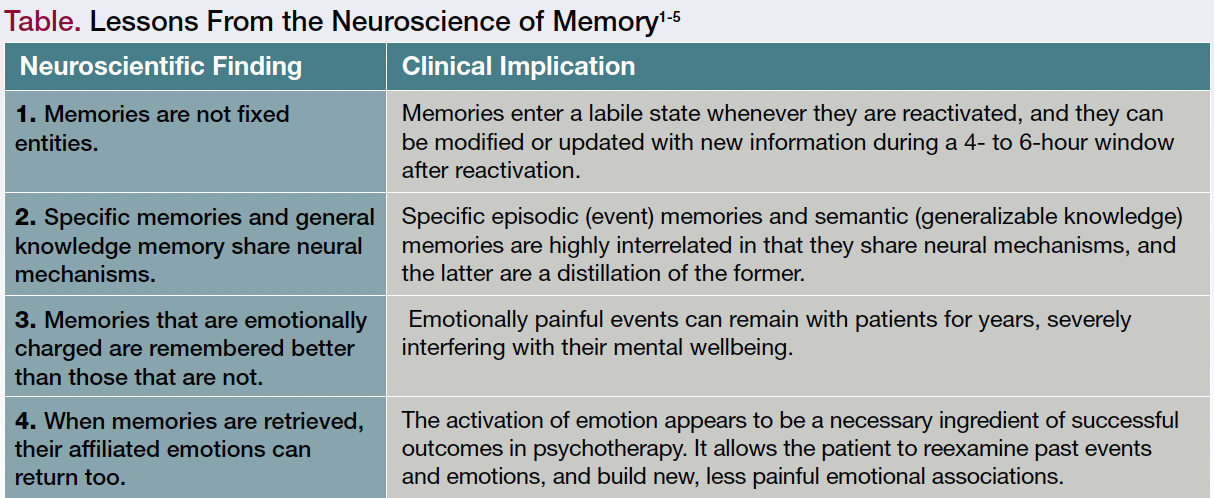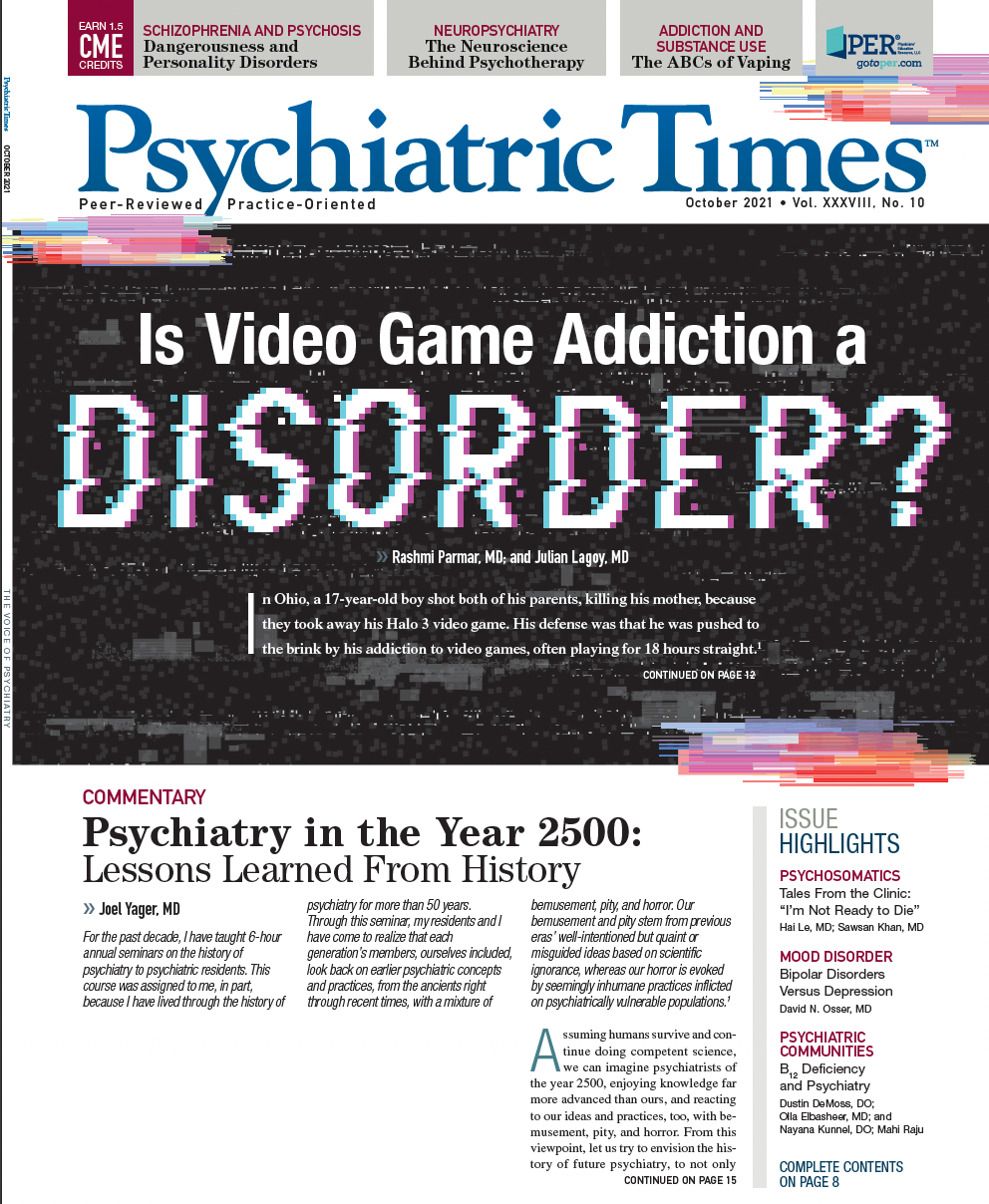Publication
Article
Psychiatric Times
A Brain-Based Approach to Psychotherapy
Author(s):
stmool/AdobeStock

CLINICAL REFLECTIONS
Psychotherapy is one of the oldest items in the clinical toolkit. Yet, despite its familiarity, it remains somewhat mysterious. How does it actually work? What are the neural mechanisms by which psychotherapies (cognitive behavioral therapy [CBT], psychodynamic therapy, and others) create lasting changes in patients’ mental health?
For several years, I have worked with other researchers in pursuing the answers to these questions into the frontiers of memory neuroscience. Our goal is to capitalize on major advances in our understanding of the neural basis of memory, emotion, and emotion-memory interactions. If we could start to explain the basic mechanism of action behind psychotherapy, then maybe we could understand how to conduct psychotherapy more effectively, with the ultimate goal of working with our patients to produce transformational and durable change.
The Frontiers of Memory Neuroscience
Recent studies have made important discoveries about the neural mechanisms underlying memory, and 4 are of particular interest (Table).1-5
Table. Lessons From the Neuroscience of Memory1-5

Drawing upon these observations, my colleagues and I hypothesized that there were 3 key ingredients to lasting change in psychotherapy:
1. activating problematic memories and the associated painful affect;
2. concurrently engaging new emotional experiences that change old memories through reconsolidation;
3. reinforcing the strength of new memories and their semantic structures by practicing new ways of behaving and experiencing the world in a variety of contexts.
We briefly discussed the application of this model to 4 different psychotherapy modalities including behavioral, cognitive behavioral (CBT), emotion focused (EFT), and psychodynamic psychotherapies in a previous article.4
Bringing the Research Into the Clinic
Realizing that there was much more to say about this new way of understanding change in psychotherapy, I coauthored a book that expands upon our previous research in 3 sections.6 The basic science section includes chapters on emotion, memory, emotion-memory interactions, the role of language in shaping emotion and memory, and the role of sleep in memory consolidation and reconsolidation. The clinical section includes chapters from leading experts in psychodynamic psychotherapy, CBT, EFT, coherence therapy, and integrative approaches. Each author considers the role of memory reconsolidation in both psychotherapy and achieving lasting personal change. The final section includes chapters on recurrent maladaptive patterns, a computational neuroscience perspective on the proposed model, and a discussion of a proposed preclinical and clinical research agenda. Considerable effort was made within and across chapters to promote cross-fertilization between basic science and clinical application.
If one takes this model seriously it could influence psychiatric practice in several ways. For example, it is useful to consider how interventions might be adjusted in therapies that have stalled or failed. Rather than talking about feelings with the goal of promoting insight, it is also important to experience feelings, especially the old painful feelings, from which individuals have protected themselves for years, and to juxtapose these feelings with corrective emotional experiences.
Another clinical implication emerges from the observation that consolidation of emotional memories occurs primarily during REM sleep. Because reconsolidation may work in the same way, medications that inhibit REM sleep may be counterproductive to enduring change in psychotherapy. It is, therefore, important to know that selective serotonin reuptake inhibitors, serotonin-norepinephrine reuptake inhibitors, tricyclics, and benzodiazepines inhibit REM sleep, whereas trazodone, bupropion, and mirtazapine do not.7,8 The book describes these and other implications, and provides a fresh perspective on how psychotherapy practice may be optimized and integrated in psychiatric care.
Exploring the Backstory: What Led to My Interest
My interest in this topic emerged over the course of my 35-year career as an academic psychiatrist. I was initially trained as a clinical psychiatrist and psychodynamic psychotherapist and have continued to practice and supervise residents ever since. I was also fortunate enough to receive research training (resulting in a PhD in experimental psychology) that focused on cognitive neuroscience and functional neuroimaging of emotion. I have found the dialogue between the basic science of psychiatry and its clinical application to be particularly enriching and informative.
In my role as educator, I have become well acquainted with the challenges (eg, significant differences in the theoretical backgrounds, mindset, and clinical interventions required by these different approaches) psychiatry residents face in developing competence in CBT, psychodynamic psychotherapy, and supportive psychotherapy. Because there is a strong interest in finding common factors and common mechanisms across psychotherapy modalities, it occurred to me that a systems neuroscience perspective could provide an integrative mechanistic framework that would highlight commonalities instead of divergences. Moreover, the goal of integrating pharmacotherapy and psychotherapy is likely to be advanced by explaining how each works in brain-based terms.
Concluding Thoughts
It is important to emphasize that we have not yet established that change in psychotherapy occurs through memory reconsolidation. One of the conclusions of our book is that a focus of intervention is recurrent maladaptive patterns, which can be understood as an expression of schemas. Schematic memory is a type of semantic memory and, as an area of neuroscientific investigation, it is relatively new. It remains to be demonstrated empirically that schematic memories can be updated with emotional information. If so, it must then be determined whether this applies to psychotherapy. Although research of this type is still underway, it might be argued that it is important to consider the clinical implications of this model if it were true.
Dr Lane is a professor of psychiatry, psychology, and neuroscience at the University of Arizona. Along with Lynn Nadel, PhD, Lane is the author of Neuroscience of Enduring Change: Implications for Psychotherapy.
References
1. Phelps EA, Hofmann SG. Memory editing from science fiction to clinical practice. Nature. 2019;572(7767):43-50.
2. Ryan L, Hoscheidt S, Nadel L. Perspectives on episodic and semantic memory retrieval. In: Dere E, Easton A, Huston J, Nadel L, eds. Handbook of Episodic Memory. Elsevier; 2008:5-18, 616.
3. Kalbe F, Schwabe L. Beyond arousal: prediction error related to aversive events promotes episodic memory formation. J Exp Psychol Learn Mem Cogn. 2020;46(2):234-246.
4. Lane RD, Ryan L, Nadel L, Greenberg L. Memory reconsolidation, emotional arousal, and the process of change in psychotherapy: new insights from brain science. Behav Brain Sci. 2015;38:e1.
5. Auszra L, Greenberg LS, Herrmann I. Client emotional productivity-optimal client in-session emotional processing in experiential therapy. Psychother Res. 2013;23(6):732-746.
6. Lane RD, Nadel L, eds. Neuroscience of Enduring Change: Implications for Psychotherapy. Oxford University Press; 2020.
7. Doghramji K, Jangro WC. Adverse effects of psychotropic medications on sleep. Psychiatr Clin North Am. 2016;39(3):487-502.
8. Borbély AA, Mattmann P, Loepfe M, et al. Effect of benzodiazepine hypnotics on all-night sleep EEG spectra. Hum Neurobiol. 1985;4(3):189-194. ❒







